

The commercial auto insurance market has been on a wild ride in recent years. Prior to the COVID-19 pandemic, this was slated as one of the most challenging lines of insurance business – and for good reason.
Over the past decade, industry loss ratios have deteriorated dramatically due to challenges around social inflation, large jury awards, and a general rise in auto claim costs. In response to these challenging conditions, commercial auto carriers have raised rates for both primary and excess/umbrella coverage, while also limiting capacity and applying strict risk selection and underwriting criteria.
There was some brief respite in auto insurance during the COVID-19 pandemic. As explained in Gallagher’s Spring/Summer Insurance Market Report, claims in auto associated with pandemic shutdowns were down in 2020, with the biggest reduction in commercial auto.
Through Q1 of 2022, total miles driven was almost back to pre-pandemic levels, and claims in auto returned to more or less “normal” levels. But the current risk landscape is anything but standard for commercial auto carriers.
“On the liability side, we continue to see challenges around social inflation, which is leading to larger and catastrophic claims,” said Linton “B” Puckett, VP, market relations leader for Gallagher. The Gallagher Spring/Summer Insurance Market Report states that, in particular, large jury awards in commercial auto insurance (in excess of $10 million) are becoming increasingly prevalent.
“As the courts have reopened post-COVID, we haven’t seen any signs of social inflation or the rise in large jury awards slowing down,” said Puckett. “This is particularly challenging for companies with large fleets.”
Today, there are also challenges around inflationary trends impacting loss costs, which will ultimately be felt through the premiums that carriers are charging. Supply chain disruptions and a labor shortage triggered by COVID have made it hard for automakers and repair shops to meet demand. Prices for both new and used vehicles have skyrocketed, driving up claims costs and auto insurance rates.
Companies with large fleets or poor loss history may experience more significant rate increases in the coming months, according to Gallagher. The brokerage also warned that carriers insuring large commercial fleets are looking to attach excess layers above $1 million.
So, despite a brief breathing period during the pandemic, the commercial auto market remained challenging. Puckett explained why: “I think the insurance carriers knew that COVID was a point in time. It did create this situation where there was a bit of a breather, with less traffic and less vehicles on the road, but it didn’t change what we were seeing from a trend standpoint.
“We didn’t really see a whole lot of change in the pricing models from the insurance carriers towards commercial auto during COVID. They held their line on what they felt they needed from a rate standpoint, and what they needed from a terms and conditions standpoint, because they knew that COVID was simply a point in time and that we were going to return to a sense of normalcy. They needed to ensure they weren’t going to amend rate for a brief moment in time as that would have created some challenges.”
The broker community has grown used to the hard market conditions in commercial auto, according to Puckett, who believes that clients have also developed a better understanding and expectation of the challenges impacting the marketplace. There’s less “panic,” he said, around the notion of significant rate increases and capacity reductions, and more focus on program structure and best-practice risk management.
“It all centers around fleet safety and training,” he told Insurance Business. “Even in the underwriting process, there’s a lot more attention on that than there was six to seven-years-ago. Well-documented training programs and well-documented fleet safety programs are critical right now in the underwriting process.
“If a client can demonstrate that they’ve got strong safety protocols and processes in place, that will result in more appetite for that risk in the carrier community, and ultimately, stronger safety programs drive better performance from a loss standpoint.”
Looking ahead, Gallagher expects to see third-party litigation continuing to drive up claim costs and prices in the coming years. The brokerage also expects rate increases to continue into 2022, yet be more moderate in the coming months.
“Rates have not kept pace with loss trends in commercial auto,” Puckett explained. “I think there’s still some catchup that carriers have to do in order to get their rates to a point where they’re adequate, and ultimately, where they’re exceeding loss trends. That hasn’t happened yet, and I don’t think it’s going to happen any time soon.
“I do think that with all the progress the industry is making around safety and technology, we can get there, but the challenge we still have is distracted driving – and that’s not going away. When we see injuries as a result of road accidents, the awards and the verdicts continue to rise, so we need to keep a close eye on social inflation and what that’s going to mean for auto liability as we move forward.”
